If you were expecting some kind of sun sign nonsense, forget it. This is real astrology. See the section above. And if you need help deciphering the astrological glyphs in the graphics accompanying this article, see Astroglyphs: Astrological Symbols Guide. Please note: this forecast is expressed in terms of Universal Time (UT).
The future is here.
It's just not widely distributed yet.
-- William Gibson
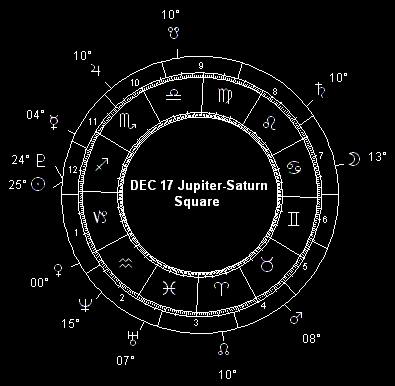 It often happens that a year has a kind of celestial theme to it. Venus, prominent by virtue of its rare transit across the solar disk in 2004, was that year's cosmic significator. And 2004 turned out to see a modest return to prosperity in the world economy, exactly as I had forecast from reading the prominent Venus factor in advance. Likewise 2003, the year of the Red Planet, saw Mars makes its closest approach to Earth since the time of the Neanderthals. And again as forecast, Gulf War II was on: you see the signs in the sky, you know what they mean, so you can say what will happen with some confidence.
It often happens that a year has a kind of celestial theme to it. Venus, prominent by virtue of its rare transit across the solar disk in 2004, was that year's cosmic significator. And 2004 turned out to see a modest return to prosperity in the world economy, exactly as I had forecast from reading the prominent Venus factor in advance. Likewise 2003, the year of the Red Planet, saw Mars makes its closest approach to Earth since the time of the Neanderthals. And again as forecast, Gulf War II was on: you see the signs in the sky, you know what they mean, so you can say what will happen with some confidence.
For 2005, there is no single major planetary theme. Mars is back in force, so like 2003 we can expect a year of blood and iron. But Venus is back in force too, so prosperity won't give way to conflict. Other long-range celestial factors appear for the first time in a generation; namely the triple Jupiter-Saturn waxing quadrature, a sign that social, political and cultural conflict will be adjusted rather than fought out to the bitter end. The times, in short, are changing in a way we haven't seen in sixty years now. And then there's the lunar declination cycle, which this year enters the home stretch of a cycle that peaks in spring 2006, when the Moon's oscillation above and below the celestial equator hits the peak toward which it's been building since 1987. You remember 1987, don't you? The last major stock market plunge off a cliff . . . There's more to this lunar declination peak than wild market fluctuations (in commodities as well as equities). Lunar extremes like this point to geocosmic stress factors associated with the risk of major tidal, storm and seismic activity. (The December 26, 2004 Sumatran earthquake and subsequent killer mega tsunami occurred on the very day of the Moon reaching its maximum declination north of the equator.)
Some of the very most important factors just mentioned don't happen at all, or don't really hit their stride, until the second half of 2005 - and more properly the fourth quarter. That's not to say the early part of 2005 is a snoozer, because it starts with a bang in its own right. But it does mean that by the end of the year, the whole world will be working in a way that makes 2004 look rather antique. As an example of one of those major factors that arrives late, consider brilliant Venus . . .
Venus goes through one of its infrequent intersolar phases late in 2005, which means Earth's nearest planetary neighbor will be extra near this year, being on the same side of the Sun as our home planet. The Venus intersolar cycle begins November 3, as the "evening star" (Venus Vesper) reaches maximum elongation east of the Sun. The cycle continues through Venus' retrograde (backwards motion as seen from Earth), from December 24, 2005 through February 3, 2006. It reaches perhaps its most intensive phase when Venus makes its inferior conjunction to the Sun on January 13, 2006; when Earth, Venus and Sun are all lined up with Venus between Earth and Sun. And the cycle wraps up on March 25, 2006, as Venus Lucifer (the "morning star") attains maximum elongation west of the Sun and passes behind the plane of the Sun as seen from Earth.
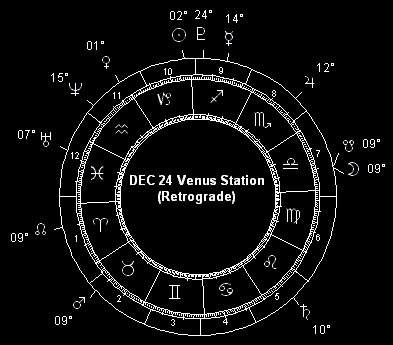 The 2005-2006 Venus intersolar cycle will be only a pale shadow of the one that occurred in 2004, which included an Earth-Venus-Sun alignment so precise that Venus made one of its rare transits across the solar disc. Still, it's better to have one of these cycles than not. There was none in 2000, the beginning of a significant economic slowdown, for example. Last year's extra prominent Venus intersolar cycle coincided with a certain measure of improvement in the global economy. This year, the economic indicators are not quite so favorable, but at least modestly so. Correspondingly, an undercurrent of economic growth will be part of the picture in 2005, especially late in the year as Venus goes intersolar. There are other indicators of a less favorable nature, so no one should expect unmitigated economic and financial improvement on a broad scale. Horrid oil price shocks will play havoc with the world economy off and on, enough to keep 2005 from getting any really positive momentum in terms of global trade, markets and manufacturing. But modest improvement beats disaster by a long shot, and the late year Venus intersolar cycle suggests that modest, uneven improvement appears to be the theme for 2005 - especially later in the year and on into early 2006.
The 2005-2006 Venus intersolar cycle will be only a pale shadow of the one that occurred in 2004, which included an Earth-Venus-Sun alignment so precise that Venus made one of its rare transits across the solar disc. Still, it's better to have one of these cycles than not. There was none in 2000, the beginning of a significant economic slowdown, for example. Last year's extra prominent Venus intersolar cycle coincided with a certain measure of improvement in the global economy. This year, the economic indicators are not quite so favorable, but at least modestly so. Correspondingly, an undercurrent of economic growth will be part of the picture in 2005, especially late in the year as Venus goes intersolar. There are other indicators of a less favorable nature, so no one should expect unmitigated economic and financial improvement on a broad scale. Horrid oil price shocks will play havoc with the world economy off and on, enough to keep 2005 from getting any really positive momentum in terms of global trade, markets and manufacturing. But modest improvement beats disaster by a long shot, and the late year Venus intersolar cycle suggests that modest, uneven improvement appears to be the theme for 2005 - especially later in the year and on into early 2006.
Speaking of matters financial, one of the bigger themes in global markets since Saturn entered Cancer in 2003 has been the US dollar's decline relative to major currencies around the world. That Saturn transit through Cancer ends in July 2005, and so should the dollar drop. I'm not forecasting a rocket-like recovery in the dollar, mind you. You can't dig a hole that deep and then get out of it in a single bound. But if you're playing the currency game, the time to stop betting against the dollar is in sight. While most metals, and especially platinum, copper and silver (plus industrial metals and alloys), will continue on a generally upward price path for the year as a whole, gold shows signs of being an exception: positive for the first half of the year, and then losing its momentum in the second half. None of which can happen without some measure of fiscal sanity in Washington, which brings to mind the Jupiter-Saturn square of 2005-2006 . . . more on that in a moment.
Other financial themes at play this year include Jupiter's Libra transit, which lasts until October 26. It's good for lawyers and the courts generally, and for companies producing drugs or equipment that treat the kidneys, ovaries and adrenal glands. Jupiter's shift into Scorpio on October 26 is good for defense contractors, police and medical (including emergency) equipment manufacturers, and banks and investment firms. This time period suggests a shift from slow but regular small increments in interest rates, to more dramatic increases.
Speaking of Jupiter and Saturn, they combine to comprise what may be the year's foremost astrological signature; certainly one of the very most important, at any rate. It's the first quadrature (square aspect, a 90 degree arc between these two planets as seen from Earth) of Jupiter and Saturn since the epochal conjunction in the year 2000, and it happens on December 17. Jupiter and Saturn will be within a few degrees of their exact square aspect (10° 45' Scorpio to Leo respectively) throughout December and into early January. And the aspect will be reoeated, due to retrogrades, in June and October of 2006. This will be the first "three-peat" Jupiter-Saturn waxing square since the 1945-1946 triplet (the third instance of which was also in the Scorpio-Leo sign pairing).
Any Jupiter-Saturn square represents a critical moment of social, cultural and political change. It's a time when ideology and reality are so out of balance that a readjustment is not only inevitable, but almost easy - even if the medicine tastes awful going down. Certainly this will be played out in American politics, and in international relations as well: tensions and conflicts won't disappear, but adjustments will be made so that the stalemates of 2004 will grudgingly turn into progress in 2005. Iraq will still be a bloody mess and a huge problem for the US. History plainly records that the only way industrial, nationalistic civilizations have ever pacified tribal societies like Iraq is genocide, and that's not going to happen now the way it did with the aboriginal inhabitants of the New World and Australia in centuries past - mainly because in a totally connected world, there are too many witnesses. (I'm not saying it will never happen - just not now. And the thing is, the genocide can go either direction now, instead of only one way.)
The kind of social, cultural and political change signified by the 2005-2006 Jupiter-Saturn square is not the kind that one side forces on the other, but one that each side settles for because it can't force the issue its own way. Think of the 1945-1946 stalemate between the US and Russia. In the aftermath of the 1945-1946 triple Jupiter-Saturn waxing square, two ideological foes who had become allies of convenience, found themselves face to face and armed to the teeth once their common enemies had been defeated. Neither had the strength or resolve to defeat the other in outright conflict, so they settled into what came to be called the Cold War. There's another Cold War brewing again, now that the triple waxing Jupiter-Saturn square has returned: an uneasy, probing confrontation. In domestic politics, in international relations, in the clash of civilizations, it's a Cold War brewing.
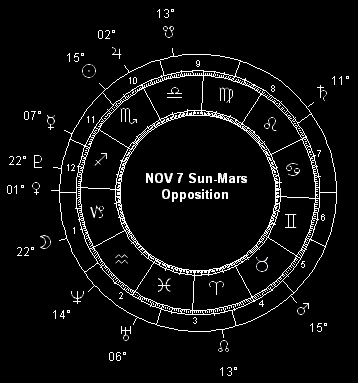 The Red Planet is going to be big again this year, for the first time since 2003. Prominent Mars years, when Earth and Mars are relatively near each other, come once every two years, give or take a month or so. They correspond to the Sun-Mars opposition, which occurred in 2001 (a few months before the 9/11 attack) and in 2003 (as the insurgency phase got underway in Gulf War II). The latter Mars alignment was historic, the closest pass between Earth and Mars since Neanderthal Man. It was chief among the factors that led to my 2003 World Forecast prediction that the Persian Gulf War II would break out that year, and then get really messy that summer: "Whoever thinks a swiftly concluded Persian Gulf War II settles the world into a Pax Americana early in 2003 is tragically mistaken. This late summer super Mars thing says peace and quiet remains far away, that danger and conflict are close at hand."
The Red Planet is going to be big again this year, for the first time since 2003. Prominent Mars years, when Earth and Mars are relatively near each other, come once every two years, give or take a month or so. They correspond to the Sun-Mars opposition, which occurred in 2001 (a few months before the 9/11 attack) and in 2003 (as the insurgency phase got underway in Gulf War II). The latter Mars alignment was historic, the closest pass between Earth and Mars since Neanderthal Man. It was chief among the factors that led to my 2003 World Forecast prediction that the Persian Gulf War II would break out that year, and then get really messy that summer: "Whoever thinks a swiftly concluded Persian Gulf War II settles the world into a Pax Americana early in 2003 is tragically mistaken. This late summer super Mars thing says peace and quiet remains far away, that danger and conflict are close at hand."
This year's Sun-Mars opposition, in short, suggests that 2005 will make 2004 look relatively calm and peaceful. Which is to say that warfare, terror attacks, military confrontation and the like will be even more abundant this year than last - if that can be believed. From collective violence like war to individual violence like murder and other criminality, and even including accidents and crashes and fires and explosions due to recklessness or evil intent and sometimes just plain bad luck (e.g. a lightning strike), this will not be a safe and peaceful year in many respects - especially within a week or so of the many strong Mars alignments of 2005. These include the Sun-Mars opposition and Mars-Neptune square on November 7 first and foremost - worldwide in scope, but especially prominent in the US Pacific coast states and along arcs through the Middle East and Russia as well as Ireland and Scotland, China and Japan, Papua New Guinea and Australia. Other strong Mars periods come within a week or so of January 1, in the aftermath of the December 31, 2004 Mars-Uranus square; January 28 (Mars aligns with Pluto), April 13 (Mars-Neptune conjunction), May 15 (Mars-Uranus alignment), June 26 and December 5 (Mars opposing Jupiter), October 1 (the Red Planet's retrograde station), December 10 (Mars' direct station), December 28 (Mars squares Saturn). In fact the whole Mars retrograde period (October 1 to December 10) is just plain edgy, pretty much day in and day out. Other peak risk dates include July 10 (Mars reaches 19 Aries, the degree of the April 8 solar eclipse), July 27 (Mars at 0 Taurus, the degree of the April 19, 2004 solar eclipse), and August 6 (Mars at 5 Taurus, the degree of the October 28, 2004 lunar eclipse). Dangers aside, these Mars periods are not all bad. They're times when bravery and daring can do the seemingly impossible.
As for the spiraling lunar cycle mentioned in the introduction, it's best followed in terms of the SuperMoons and eclipses of 2005. There are four SuperMoon (perigee-syzygy) alignments this year, including one of the most extreme of its type in a dozen years. SuperMoon is a term I coined for my 1979 article in Dell HOROSCOPE magazine, wherein I predicted Savannah, Georgia getting hit by a hurricane on September 6, 1979. (That issue was on the stands six weeks before Hurricane David hit Savannah on September 6.) The term describes a new or full moon (syzygy) which occurs when the Moon is at or near (within 90% of) its closest approach to Earth (perigee). This year's perigee-syzygies include a pair of new moons (an extreme SuperMoon at 20 Capricorn on January 10 and 20 Aquarius on February 8), and two full (at 29 Capricorn on July 21 and 27 Aquarius on August 19). The eclipses of 2005 come in April (a solar eclipse at 19 Aries on the 8th, a lunar eclipse at 4 Scorpio on the 24th) and October (a solar eclipse at 10 Libra on the 3rd and a lunar eclipse at 24 Aries on the 17th). The April 24 lunar eclipse marks the last of the current Taurus-Scorpio eclipse series, which began with the Taurus lunar eclipse in the fall of 2002. Even an ordinary new or full moon raises powerful tides in Earth's seas, atmosphere and crust; increasing the potential for strong storms, tidal flooding and seismic activity. SuperMoons and eclipses are extraordinary new and full moons, and are accompanied by extraordinary risks of natural calamity.
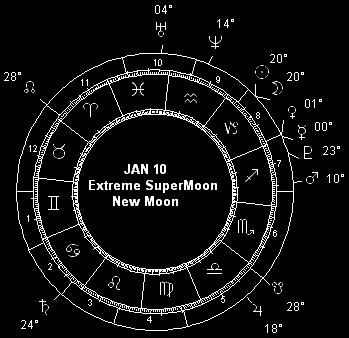 An extreme SuperMoon is a rare bird indeed. It's one that occurs with the Moon about as close to Earth as it ever gets. The last extreme SuperMoon took place on March 8, 1993. Perigee was at 08:36 UT (Universal Time) that day, just over an hour ahead of the full moon, and just two hours before the Moon crossed the celestial equator from north to south. It was the closest lunar perigee of the year, bringing the Moon only 356,529 kilometers away from our home planet. (That's within 175 kilometers of the Moon's closest approach in centuries.) You remember March '93, don't you? Think back to "The Perfect Storm," aka "The Storm of the Century." It got its start with a low pressure system that formed over the Gulf of Mexico on March 11 . . . and then there was the Richter 5.7 quake in northern Oregon on March 5, the pair of Richter 6.6 tremors in the South Pacific the following day, and the 6.4 in the South Sandwich Islands on the 10th . . . all within the plus or minus three day window in time surrounding the SuperMoon.
An extreme SuperMoon is a rare bird indeed. It's one that occurs with the Moon about as close to Earth as it ever gets. The last extreme SuperMoon took place on March 8, 1993. Perigee was at 08:36 UT (Universal Time) that day, just over an hour ahead of the full moon, and just two hours before the Moon crossed the celestial equator from north to south. It was the closest lunar perigee of the year, bringing the Moon only 356,529 kilometers away from our home planet. (That's within 175 kilometers of the Moon's closest approach in centuries.) You remember March '93, don't you? Think back to "The Perfect Storm," aka "The Storm of the Century." It got its start with a low pressure system that formed over the Gulf of Mexico on March 11 . . . and then there was the Richter 5.7 quake in northern Oregon on March 5, the pair of Richter 6.6 tremors in the South Pacific the following day, and the 6.4 in the South Sandwich Islands on the 10th . . . all within the plus or minus three day window in time surrounding the SuperMoon.
This year's January 10 extreme SuperMoon sees Luna approach to just 356,571 kilometers from Earth - the closest approach of the year, and within about 200 kilometers of the nearest pass in centuries. And it occurs less than 24 hours after the Moon reaches its extreme declination south of the celestial equator; with Jupiter in the same sign (Libra) as it was back in 1993. Another "Perfect Storm," as occurred the last time there was a SuperMoon so close to Earth? Not exactly. But as with any SuperMoon, you can expect extreme natural calamities to make plenty of headlines around the time of this unusual alignment. Severe storms with high wind and heavy precipitation (raising the risk of floods, mudslides and blizzards), higher than normal tides, and moderate to severe seismic activity (Richer 5+ quakes as well as volcanic eruptions, either of which could raise dangerous tsunamis if they occur at sea) -they're all on tap during the plus or minus three day window surrounding January 10's extreme SuperMoon alignment. And coming as it does within a week of Earth's perihelion (closest approach to the Sun) and with the full moon opposing Saturn in a T-Square configuration with Jupiter . . . well, this looks like a big one.
Don't get me wrong, I'm not saying all hell is going to break loose all over the world. I'm just saying that there will be a much higher than normal risk of extreme storm, tidal and seismic events during the January 7-13 window. Having your emergency kit ready, your fuel tank full and your batteries charged up: not a bad idea at all. Since virtually no place is beyond the reach of these natural phenomena, it's a good idea to keep an eye on the sky and an ear cocked for the news during this period, no matter where you live. That said, astro-locality analysis points out some areas which may be especially vulnerable during the January 7-13 SuperMoon window. They include an arc sweeping northeasterly from San Diego through Billings, across Iceland and down through Copenhagen into eastern Europe and down into the Middle East; a couple of pole to pole north-south zones passing through Rio de Janeiro in the west and from Tokyo down through Adelaide in the east, as well as another pair passing through London and Paris in the west and down through Wrangel Island in the East Siberian Sea; and finally another arc running northeasterly through Central America, across Cuba and along the US Atlantic coast from Florida to New England, crossing Baffin Island, Greenland and Iceland to track across Scandinavia down through Russia into Afghanistan and across India (passing near Delhi) and then skirting the coast west of Indonesia and Australia. (Be sure to examine the Mars and Saturn horizon and meridian lines on the astro-locality map.) Earth is a big planet after all, which means most of us will be unscathed - but for those in the crosshairs, a little preparation won't hurt a bit.
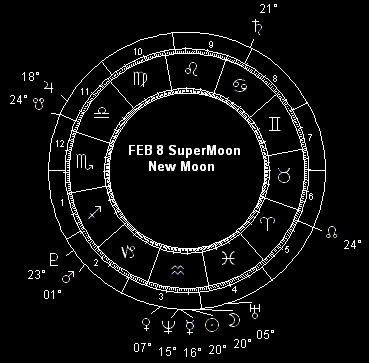 The February 8 SuperMoon is another indicator of increased tidal, storm, and seismic risk, in effect February 5-11. As always, being planetary in scale, there's no place on Earth that can't be targeted by this sort of natural upheaval during the indicated period. So be ready, just in case. And maybe especially if you live or will be in one of the astro-locality zones of possible special risk. Among these is a north-south longitudinal zone that runs through Hawaii and western Alaska, and another that goes through eastern Europe and the heart of Africa. Another pole to pole north-south zone crosses eastern Greenland and western Iceland, while yet another skirts the east coast of Australia and runs northward through the East Siberian Sea. East Asia from Yakutsk through the Korean Peninsula and down through the Philippines across Indonesia lies under the east end of an arc of vulnerability, which emerges on the other side of the world to run northwesterly through the center of South America, crossing the Caribbean to pass right through Washington DC and out through northwestern Canada. (Don't forget those Mars and Saturn horizon and meridian astro-locality lines.)
The February 8 SuperMoon is another indicator of increased tidal, storm, and seismic risk, in effect February 5-11. As always, being planetary in scale, there's no place on Earth that can't be targeted by this sort of natural upheaval during the indicated period. So be ready, just in case. And maybe especially if you live or will be in one of the astro-locality zones of possible special risk. Among these is a north-south longitudinal zone that runs through Hawaii and western Alaska, and another that goes through eastern Europe and the heart of Africa. Another pole to pole north-south zone crosses eastern Greenland and western Iceland, while yet another skirts the east coast of Australia and runs northward through the East Siberian Sea. East Asia from Yakutsk through the Korean Peninsula and down through the Philippines across Indonesia lies under the east end of an arc of vulnerability, which emerges on the other side of the world to run northwesterly through the center of South America, crossing the Caribbean to pass right through Washington DC and out through northwestern Canada. (Don't forget those Mars and Saturn horizon and meridian astro-locality lines.)
The next geocosmic risk window of 2005 is centered on the April 8 solar eclipse, which is of the unusual hybrid variety; so called because it's a total eclipse as seen from some locations, and an annular eclipse as seen from other places. Solar eclipse windows tend to run a little larger than any other type of new or full moon. Figure this one to be in effect from April 1 through the 15th. And figure it could come close to rivaling the January 10 extreme SuperMoon in terms of accompanying severe storms, moderate to severe earthquakes and volcanic eruptions. Like that earlier alignment, this one is part of a T-Square pattern that includes Jupiter and Saturn (also Venus). It also comes with the Moon on the celestial equator (crossing from south to north). Just to be on the safe side, this would be a good time to freshen your emergency kit and keep in touch with the news, the Weather Channel, your weather radio, whatever. Most of us will be completely unscathed, but more than a few people will face freakish weather, flooding, heavy precipitation, tornadoes, thunderstorms and such. And some will have seismic upheaval to deal with as well. So be prepared and stay tuned in between the 1st and the 15th, just to be on the safe side.
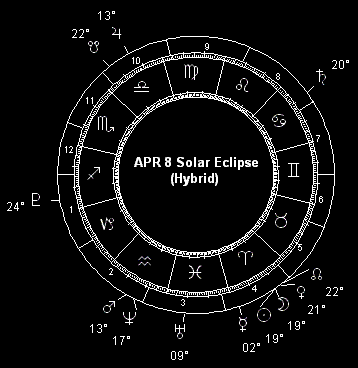 Remembering that an eclipse is an alignment of cosmic proportions, you've got to expect that it's planetary in scope. Consequently, anywhere on Earth could be a target zone for storms, floods and seismicity during the April 1-15 eclipse window; although our home planet is quite large enough that most of us will emerge unscathed through the miracle of statistics. Feeling lucky? Then don't prepare in any way at all. On the other hand, if you live in one of the eclipse's zones of visibility, you have a rather obvious reminder that you're part of a cosmic alignment. A partial eclipse will be seen from much of North and South America and New Zealand, but the full eclipse will be visible only along a path from southeast of New Zealand across the Pacific Ocean to Central America: this is a primary zone of special vulnerability to tidal, seismic and meteorological disturbances from the 1st through the 15th of April. Other zones of vulnerability, as suggested by astro-locality mapping, include the Pacific coast of North America from Alaska down to northern California; the eastern tip of South America; Iceland, Japan, Indonesia and eastern Australia; the Middle East and central Russia; and along a north-south longitudinal from Ireland down through Spain and west Africa. (Be sure to check out the Mars and Saturn horizon and meridian lines on the astro-locality map.)
Remembering that an eclipse is an alignment of cosmic proportions, you've got to expect that it's planetary in scope. Consequently, anywhere on Earth could be a target zone for storms, floods and seismicity during the April 1-15 eclipse window; although our home planet is quite large enough that most of us will emerge unscathed through the miracle of statistics. Feeling lucky? Then don't prepare in any way at all. On the other hand, if you live in one of the eclipse's zones of visibility, you have a rather obvious reminder that you're part of a cosmic alignment. A partial eclipse will be seen from much of North and South America and New Zealand, but the full eclipse will be visible only along a path from southeast of New Zealand across the Pacific Ocean to Central America: this is a primary zone of special vulnerability to tidal, seismic and meteorological disturbances from the 1st through the 15th of April. Other zones of vulnerability, as suggested by astro-locality mapping, include the Pacific coast of North America from Alaska down to northern California; the eastern tip of South America; Iceland, Japan, Indonesia and eastern Australia; the Middle East and central Russia; and along a north-south longitudinal from Ireland down through Spain and west Africa. (Be sure to check out the Mars and Saturn horizon and meridian lines on the astro-locality map.)
Be aware that this eclipse falls within the March 12 to April 26 Mercury intersolar phase, which suggests that commerce and transport and infrastructure generally (including the power grid, the Internet etc.) are all particularly vulnerable to disruption during the eclipse. Things like storms (atmospheric as well as solar) and other forms of nature run amok are especially likely to bring such systems grinding to a halt at times like this. Anything you can deploy in the way of a backup system or a fallback plan would probably be a good idea about now.
Aside from its geocosmic significance in terms of rippling tides in Earth's crust, sea and atmosphere, the April 8 eclipse has a symbolic historicity as well. It's the 51st eclipse in Saros Series 129, which began on October 3, 1103. All the eclipses in this series occur at the north lunar node (Rahu, the "dragon's head," arguably the creator of a stream of karma). The Anglo-Saxon Chronicle doesn't remember 1103 fondly: "This was a very calamitous year in this land, through manifold impositions, and through murrain of cattle, and deficiency of produce, not only in corn, but in every kind of fruit." (Murrain is any pestilent disease of livestock, very infectious and usually fatal, including but not limited to anthrax.) It was the year the Pisa Cathedral was completed, becoming a model for the Italian Romanesque style of Renaissance architecture. And it was the year Henry I, in a power struggle with the Pope that planted some of the seeds that lead Renaissance and Reformation, exiled St. Anselm of Canterbury. I do see some potential parallels between the first Saros 129 eclipse, and its latest incarnation. There's an emphasis on economic production, and it's not good: decreased crop and livestock production was everything in 1103. While agriculture is relatively a smaller component of total output in 2005, it's still basic. If this eclipse is any indication, agricultural commodities will be a bit scarcer this year, due to lower crop yields. And beef is once again a concern: there's anthrax of course, but in more recent years there's Mad Cow Disease. And then of course there's the culture war parallel, suggested by King Henry's ruckus in 1103 - as well as by the founding of the Aum Shinrikyo cult in 1987, the year of the first hybrid solar eclipse in Saros Series 129. This has to mean the struggle for political power between the secular and the sacred remains key this year, and it looks as though the political powers that be put the religious folk in their place somehow . . . a year in which the political establishment pays lip service to the religious, throws them a bone here and there, and then does what's in its own interest anyway. In response, some of the religious get caught up in a movement aimed at opposing the secular powers that be. It's also a year when England and western Europe get a ferocious storm in the early fall, around Michaelmas (September 29).
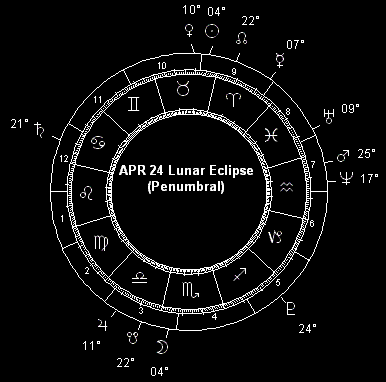 The April 24 lunar eclipse at 4 Scorpio is of the penumbral variety: rather than being blacked out by Earth's shadow, the lunar disk is only shaded, and only partially so at that. This eclipse belongs to Saros Series 141, which began on August 25, 1608 - within a day of the arrival of England's first official representative to India, in the year Captain John Smith claimed that he was saved from execution by Pocahontas. (There must be a theme about colonial exploitation there somewhere - and stories sexed-up to sell.) Of course this eclipse signals a potentially strong upsurge in severe storms, higher than normal tides and moderate to severe seismic activity (Richter 5+ quakes and volcanic eruptions). Heavy precipitation, flooding and mudslides, dangerous electrical storms - they're all par for the course during this lunar eclipse risk window, in effect April 21-27. Have your emergency kit ready, be prepared for weather-related travel and shipping delays (Mercury being intersolar, after all) . . . you know the drill. And you might want to pay special attention if you're in western North America at the time, since the entire eclipse will be visible from there. Other areas of potential vulnerability, judging from the astro-locality map for this eclipse, include an arc from southern California northeasterly through the Rockies and across Greenland, turning southeasterly through Scandinavia and western Russia down through the Middle East; also along one pair of pole to pole north-south lines roughly from Honolulu through Anchorage in the west, and through Budapest and Johannesburg in the east; and another pair from east-central Greenland down through eastern South America in the west and from Hokkaido down through Melbourne on other side of the globe; and finally along an arc that runs across northern Alaska and northwest Canada before curing down through New York and down to Caracas and Buenos Aires, then coming up through Indonesia and the Philippines to cross Taiwan, South Korea, far eastern China and Siberia.
The April 24 lunar eclipse at 4 Scorpio is of the penumbral variety: rather than being blacked out by Earth's shadow, the lunar disk is only shaded, and only partially so at that. This eclipse belongs to Saros Series 141, which began on August 25, 1608 - within a day of the arrival of England's first official representative to India, in the year Captain John Smith claimed that he was saved from execution by Pocahontas. (There must be a theme about colonial exploitation there somewhere - and stories sexed-up to sell.) Of course this eclipse signals a potentially strong upsurge in severe storms, higher than normal tides and moderate to severe seismic activity (Richter 5+ quakes and volcanic eruptions). Heavy precipitation, flooding and mudslides, dangerous electrical storms - they're all par for the course during this lunar eclipse risk window, in effect April 21-27. Have your emergency kit ready, be prepared for weather-related travel and shipping delays (Mercury being intersolar, after all) . . . you know the drill. And you might want to pay special attention if you're in western North America at the time, since the entire eclipse will be visible from there. Other areas of potential vulnerability, judging from the astro-locality map for this eclipse, include an arc from southern California northeasterly through the Rockies and across Greenland, turning southeasterly through Scandinavia and western Russia down through the Middle East; also along one pair of pole to pole north-south lines roughly from Honolulu through Anchorage in the west, and through Budapest and Johannesburg in the east; and another pair from east-central Greenland down through eastern South America in the west and from Hokkaido down through Melbourne on other side of the globe; and finally along an arc that runs across northern Alaska and northwest Canada before curing down through New York and down to Caracas and Buenos Aires, then coming up through Indonesia and the Philippines to cross Taiwan, South Korea, far eastern China and Siberia.
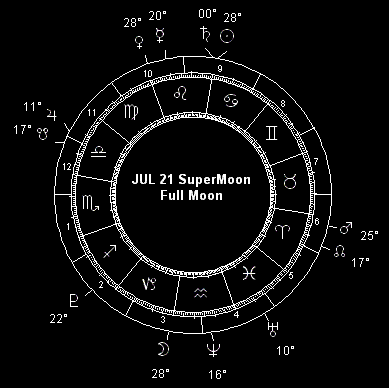 Next up in terms of major geophysical stress signals for the year is the full moon SuperMoon at 29 Capricorn on July 21st. It's in effect from the 18th through the 24th - an interval that includes the Moon reaching maximum southern declination on the 19th - and it looks foreboding: a T-Square configuration with Mars in a critical degree of Aries square (90 degree arc to) Saturn and the Sun on one hand, and the Moon on the other (making its second closest approach to Earth all year). There's bound to be plenty of news focusing on powerful storms, earthquakes, volcanic eruptions, high tides and inland flooding during this period. Thunderstorms and fires, tornadoes and cyclones, weather-related crashes: all in all, a good time to be cognizant of potential hazards and to take precautions against them as much as possible. Happening as it does during the Mercury intersolar cycle - a few days from Mercury's retrograde station, in fact - disruptions to power, information and transport are highly likely during this SuperMoon window. Severe weather (including cosmic weather, such as solar flares) and other natural calamities are bound to be at the root of much of the mess that happens during this period, but I also see human mistakes and mischief playing an important part.
Next up in terms of major geophysical stress signals for the year is the full moon SuperMoon at 29 Capricorn on July 21st. It's in effect from the 18th through the 24th - an interval that includes the Moon reaching maximum southern declination on the 19th - and it looks foreboding: a T-Square configuration with Mars in a critical degree of Aries square (90 degree arc to) Saturn and the Sun on one hand, and the Moon on the other (making its second closest approach to Earth all year). There's bound to be plenty of news focusing on powerful storms, earthquakes, volcanic eruptions, high tides and inland flooding during this period. Thunderstorms and fires, tornadoes and cyclones, weather-related crashes: all in all, a good time to be cognizant of potential hazards and to take precautions against them as much as possible. Happening as it does during the Mercury intersolar cycle - a few days from Mercury's retrograde station, in fact - disruptions to power, information and transport are highly likely during this SuperMoon window. Severe weather (including cosmic weather, such as solar flares) and other natural calamities are bound to be at the root of much of the mess that happens during this period, but I also see human mistakes and mischief playing an important part.
Of course this SuperMoon is global in scope, by definition. So no matter where you are July 18-24, be aware of the sky and the land and, if it applies to your situation at the time, the sea. Sometimes it's high ground you want, sometimes it's a good basement. That said, astro-locality analysis does show a number of suspiciously risky-looking places around the time of the July 21 SuperMoon. These include Central America, the Pacific coast of South America, the Caribbean Sea and Gulf of Mexico, all of Cuba and Florida plus most of the US Southeast and from there northwest along an arc through the Midwest and Alberta into Alaska and across the Bering Strait; thence bending southeasterly out through eastern Siberia down across the Korean Peninsula and the China coast, passing just off the coast of Vietnam and across Indonesia. I see a couple hazardous pole to pole north-south sectors as well, one cutting right through the middle of China and down through Thailand and Indonesia; and another dropping due south from just east of Juneau (passing just west of Honolulu). Last but not least is another longitudinal north-south swath through Stockholm and Vienna down through Capetown.
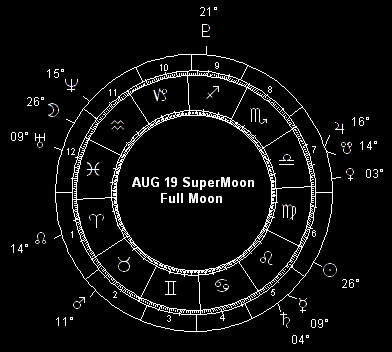 Last among this year's SuperMoon alignments is the full moon at 27 Aquarius on August 19, the Moon's third closest approach to Earth in 2005. Like its July 21st predecessor, this SuperMoon occurs during a Mercury intersolar cycle - in an especially sensitive spot in fact, within just a few days of Mercury's direct station on the 16th. So once again, the infrastructure of information, commerce and electrical connections is susceptible to disruption owing to natural calamities. What kind of natural calamities? The usual SuperMoon suspects: powerful storms with heavy precipitation and destructive winds, tidal flooding along the coasts, inland flooding and mudslides due to the aforementioned precipitation; and moderate to severe seismic activity, including Richter 5+ quakes and possible tsunamis resulting therefrom, as well as volcanic eruptions. Expect news of these things to surge during the August 16-22 SuperMoon window, and make sensible plans and preparations: allow for weather-related delays if traveling (or expecting someone who is), have your household and auto emergency kits checked out and ready just in case, keep an eye on the sky and stay tuned to your weather and emergency information media. Remember that power outages are a distinct possibility, and plan accordingly. While any of us anywhere could find ourselves facing real danger during the indicated period - this phenomenon is cosmic in natural and planetary in scope, after all - most of us will only experience such things second-hand through the news of the day. So make your preparations and stay alert just to be on the safe side, and then go about your business: that's the smart strategy.
Last among this year's SuperMoon alignments is the full moon at 27 Aquarius on August 19, the Moon's third closest approach to Earth in 2005. Like its July 21st predecessor, this SuperMoon occurs during a Mercury intersolar cycle - in an especially sensitive spot in fact, within just a few days of Mercury's direct station on the 16th. So once again, the infrastructure of information, commerce and electrical connections is susceptible to disruption owing to natural calamities. What kind of natural calamities? The usual SuperMoon suspects: powerful storms with heavy precipitation and destructive winds, tidal flooding along the coasts, inland flooding and mudslides due to the aforementioned precipitation; and moderate to severe seismic activity, including Richter 5+ quakes and possible tsunamis resulting therefrom, as well as volcanic eruptions. Expect news of these things to surge during the August 16-22 SuperMoon window, and make sensible plans and preparations: allow for weather-related delays if traveling (or expecting someone who is), have your household and auto emergency kits checked out and ready just in case, keep an eye on the sky and stay tuned to your weather and emergency information media. Remember that power outages are a distinct possibility, and plan accordingly. While any of us anywhere could find ourselves facing real danger during the indicated period - this phenomenon is cosmic in natural and planetary in scope, after all - most of us will only experience such things second-hand through the news of the day. So make your preparations and stay alert just to be on the safe side, and then go about your business: that's the smart strategy.
The planetary scope of the SuperMoon situation notwithstanding, astro-locality suggests a few zones which may be at special risk from tides, storms and seismic activity during the August 16-22 period. Among these is a longitudinal arc running through Ontario, the Great Lakes and Mississippi River Valley, into the Gulf of Mexico and across the Yucutan Peninsula into Central America, and on through the South Pacific. The same arc runs across the other side of the globe, cutting through eastern Russia, western Mongolia, China and Myanmar out into the Indian Ocean, sweeping just off the northwest coast of Indonesia. The entire Rocky Mountain chain lies under another pole to pole arc that clips the south tip of the Baja Peninsula, emerging on the other side of the world to pass over Tashkent and Kabul southward into the Indian Ocean. And then there's the Mars horizon, arcing northeasterly from the South Pacific across central Mexico, grazing Dallas and Minneapolis and then crossing western Ontario and the Hudson Bay; the same line then skims the northern Scandinavia coast to cross the Urals and swing down through Afghanistan and Pakistan before passing over the India Ocean. Another planetary horizon of note in this connection is Saturn's, which crosses from northwestern Africa into western and northern Europe (skimming Madrid, Paris, Copenhagen and Stockholm along the way), swinging across northern Russia and then southeasterly down through Hokkaido across the Pacific to New Zealand. And finally there's the solunar horizon, which runs northwesterly from Lagos on the west African coast up through Tripoli and across the Mediterranean to southern Italy, widening a bit as it heads further north to cut a swath that takes in Rome, Vienna, Warsaw and St. Petersburg.
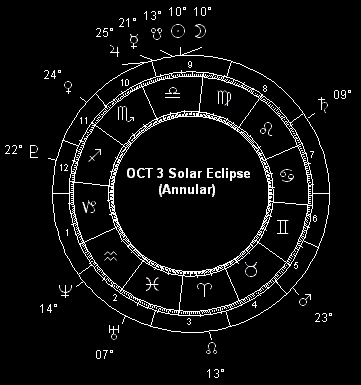 The October 3 annular solar eclipse at 10 Libra happens just hours after the Moon crosses the celestial equator, and delineates a geocosmic stress window that extends from September 26 through October 10. Peak dates during this period fall on the 2nd, 3rd and 9th, but the whole risk window is bound to be a time of unusually strong storm and seismic activity (including Richter 5+ earthquakes and volcanic eruptions), higher than normal tides, and a risk of floods and mudslides due to heavy precipitation. Such phenomena may be largely focused in the eclipse's zone of visibility (Africa and Europe plus the Middle East and India), and more specifically to the actual eclipse path (across the Iberian Peninsula and through Africa from Algeria to Somalia). But an eclipse is a massive cosmic alignment, and there's no place on Earth beyond the reach of atmospheric and seismic upheaval at such a time. So be prepared not only in the eclipse visibility zones, but wherever you may be September 26-October 10. You should know the drill by now: allow extra time for weather delays if you must travel, pay attention to the skies and any weather alerts available to you, and check to ensure that your emergency kit is ready at hand just in case. And you might want to double-check all this if you happen to be in one of the astro-locality hot spots during the solar eclipse window. These include Hawaii, Alaska, southern California and eastern Oregon, parts of British Columbia and Alberta; the southwest coastline of South America plus eastern Peru and Colombia as well as western Venezuela; the eastern Caribbean, Canadian Maritimes and Greenland; eastern Scotland and Ireland plus the north Scandinavian coastline; along a longitudinal arc from Capetown through Warsaw; in Asia, from central Mongolia and China through Indochina into Singapore, Indonesia and along the west coast of Australia; and finally along an arc from Vladivostok through Tokyo, Papua New Guinea and New Zealand.
The October 3 annular solar eclipse at 10 Libra happens just hours after the Moon crosses the celestial equator, and delineates a geocosmic stress window that extends from September 26 through October 10. Peak dates during this period fall on the 2nd, 3rd and 9th, but the whole risk window is bound to be a time of unusually strong storm and seismic activity (including Richter 5+ earthquakes and volcanic eruptions), higher than normal tides, and a risk of floods and mudslides due to heavy precipitation. Such phenomena may be largely focused in the eclipse's zone of visibility (Africa and Europe plus the Middle East and India), and more specifically to the actual eclipse path (across the Iberian Peninsula and through Africa from Algeria to Somalia). But an eclipse is a massive cosmic alignment, and there's no place on Earth beyond the reach of atmospheric and seismic upheaval at such a time. So be prepared not only in the eclipse visibility zones, but wherever you may be September 26-October 10. You should know the drill by now: allow extra time for weather delays if you must travel, pay attention to the skies and any weather alerts available to you, and check to ensure that your emergency kit is ready at hand just in case. And you might want to double-check all this if you happen to be in one of the astro-locality hot spots during the solar eclipse window. These include Hawaii, Alaska, southern California and eastern Oregon, parts of British Columbia and Alberta; the southwest coastline of South America plus eastern Peru and Colombia as well as western Venezuela; the eastern Caribbean, Canadian Maritimes and Greenland; eastern Scotland and Ireland plus the north Scandinavian coastline; along a longitudinal arc from Capetown through Warsaw; in Asia, from central Mongolia and China through Indochina into Singapore, Indonesia and along the west coast of Australia; and finally along an arc from Vladivostok through Tokyo, Papua New Guinea and New Zealand.
The October 3 solar eclipse belongs to Saros Series 134, which began with the eclipse of June 22, 1248. All the eclipses in this series occur at the south lunar node (Ketu, the "dragon's tail," where karma comes home to roost and seek redress). It was the year of the Seventh Crusade (where it was discovered that jousting armor gave protection from Saracen arrows, like Kevlar on a Humvee); but that misadventure eventually ended in defeat after six futile years. Conversely, the Spanish defeated the Muslim occupiers of Seville that year, evicting them from one of their strongholds in Europe (although it wasn't until 1492 that the last Islamic outpost in Spain was vanquished). Muslim civilization arguably led the world in 1248, which was the year one of the largest hospitals in history (Al-Mansouri) opened in Cairo, and the year Ibn Al-Baiar died in Spain (one of the greatest physicians in all history); Ridderzal Castle was completed in The Hague, a striking but empty monument to Willem II's dream of imperial glory. (Willem ordered the castle built in anticipation of being crowned Emperor, but he died in battle and the castle was then completed by Willem's son Floris V as a memorial to his father.) All in all, there are some striking parallels to our own time - the futile Crusade being chief among them. The technical supremacy of the Crusaders was ultimately overwhelmed by domestic political matters, while at the same time European civilization subdued the Islamic presence in its midst; leaving the Middle East to Middle Eastern civilization, and Europe to European civilization when all was said and done. Will it be now, as it was then? But of course . . . in the fullness of time. The clash of civilization issues become more clearly seen and grasped this year, possibly around the time of the eclipse, or perhaps more likely beginning a couple months later with the Jupiter-Saturn square (December 2005, repeated in June and December 2006).
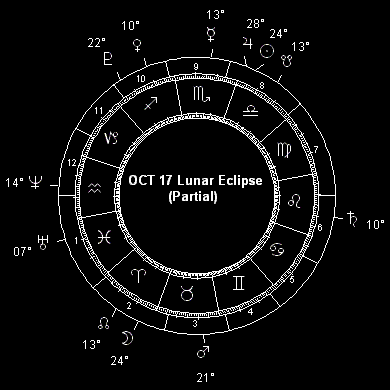 Last among the major geocosmic risk windows of 2005 is October's partial lunar eclipse at 24 Aries on the 17th. This one belongs to Saros Series 146, which began on July 11, 1843 - one of the more seismically active years in modern history. It was the year that thousands of people were killed when the town of Pointe-a-Pitre was destroyed by an earthquake and volcanic eruption on the island of Guadaloupe (in the Lesser Antilles on February 8), and a Richter 6.3 temblor occurred on the New Madrid fault (near Marked Tree AR on January 4), as well as major earthquakes in India (April 1, several cities heavily damaged), a killer Richter 7.5 tremor near Wanganui, New Zealand on July 8 (within days of the eclipse); also an earthquake-generated tsunami that stuck Japan that year; along with numerous volcanic eruptions including Mount Baker in Washington, Guntur in Java, Reventador in Ecuador, Mauna Loa in Hawaii, Iliamna in Alaska, Agung on Bali, Liamuiga on St. Kitts, Talang on Sumatra, and Etna on Sicily . . . and this is not a complete list! There was a great deal more to 1843 than seismic upheaval, to be sure: the opening of the Oregon Trail (May 22), discovery of the sunspot cycle (the German astronomer Samuel Heinrich Schwabe), British colonial power grabs in Hong Kong and Pakistan, etc.
Last among the major geocosmic risk windows of 2005 is October's partial lunar eclipse at 24 Aries on the 17th. This one belongs to Saros Series 146, which began on July 11, 1843 - one of the more seismically active years in modern history. It was the year that thousands of people were killed when the town of Pointe-a-Pitre was destroyed by an earthquake and volcanic eruption on the island of Guadaloupe (in the Lesser Antilles on February 8), and a Richter 6.3 temblor occurred on the New Madrid fault (near Marked Tree AR on January 4), as well as major earthquakes in India (April 1, several cities heavily damaged), a killer Richter 7.5 tremor near Wanganui, New Zealand on July 8 (within days of the eclipse); also an earthquake-generated tsunami that stuck Japan that year; along with numerous volcanic eruptions including Mount Baker in Washington, Guntur in Java, Reventador in Ecuador, Mauna Loa in Hawaii, Iliamna in Alaska, Agung on Bali, Liamuiga on St. Kitts, Talang on Sumatra, and Etna on Sicily . . . and this is not a complete list! There was a great deal more to 1843 than seismic upheaval, to be sure: the opening of the Oregon Trail (May 22), discovery of the sunspot cycle (the German astronomer Samuel Heinrich Schwabe), British colonial power grabs in Hong Kong and Pakistan, etc.
With its Sun-Jupiter conjunction, I can see this eclipse as signifying the blazing of new trails, theoretical breakthroughs, important legal proceedings and decisions and major political appointments. But it will surely be accompanied by disturbances in Earth's atmosphere, seas and crust as well. Powerful storms with high winds and heavy precipitation are bound to surge above the normal background level during the October 14-20 eclipse window; along with moderate to severe seismic activity (Richter 5+ quakes and volcanic eruptions) and flooding or mudslides caused by incessant rainfall. Hazards such as these are possible just about anywhere on Earth during this period, but are probably especially likely in the regions where the entire eclipse is visible; namely eastern Asia and Australia across the Pacific to the western coastline of North America. And then there are the astro-locality indicators, which may point to additional areas at special risk between the 14th and 20th of October. Among these are several longitudinal arcs running through Honolulu HI and Barrow AK, over the pole and down to Warsaw, through Capetown and back again; another running up from Bamako, Mali through Dublin, over the pole and down through Wellington, New Zealand; and a third running northward from Lima through Kingston, Jamaica and across eastern Cuba up to Washington, DC onwards through eastern Canada and back over the pole down through Siberia, central Mongolia and China and southward through Saigon and Jakarta. Also rather risky looking are the zones where the eclipse is on the horizon, along an arc northeasterly through the South Pacific, across southern Mexico and the Gulf of Mexico through the Mississippi River Valley, the Great Lakes and Ontario; across Hudson Bay, Baffin Island and Greenland; and then cutting southeasterly across Russia through Kazakhstan, and down through Tajikistan, Pakistan and India, crossing over Sri Lanka and out into the Indian Ocean. (The Mars and Saturn horizon lines are worth a look as well - see the astro-locality map.)
 Major themes aside, there are some repetitive motifs that crop up every year, but always fresh in detail. For instance, there are the cycles of Mercury. Being closest to the Sun, Mercury goes intersolar as seen from Earth more than any other planet; several times a year in fact, including the infamous Mercury retrogrades of astrological legend. For 2005, these periods when Mercury and Earth travel together on the same side of the Sun are March 12 to April 26 (including the March 20-April 12 retrograde and the March 29 Mercury-Sun conjunction); July 9 to August 23 (highlighted by the July 23-August 16 retrograde and the August 5 Mercury-Sun alignment), and November 3 to December 12 (key phases of which are the November 14-December 4 Mercury retrograde phase and the November 24 Mercury-Sun conjunction).
Major themes aside, there are some repetitive motifs that crop up every year, but always fresh in detail. For instance, there are the cycles of Mercury. Being closest to the Sun, Mercury goes intersolar as seen from Earth more than any other planet; several times a year in fact, including the infamous Mercury retrogrades of astrological legend. For 2005, these periods when Mercury and Earth travel together on the same side of the Sun are March 12 to April 26 (including the March 20-April 12 retrograde and the March 29 Mercury-Sun conjunction); July 9 to August 23 (highlighted by the July 23-August 16 retrograde and the August 5 Mercury-Sun alignment), and November 3 to December 12 (key phases of which are the November 14-December 4 Mercury retrograde phase and the November 24 Mercury-Sun conjunction).
All things Mercurial are crucial during the intersolar Mercury phases; infrastructure, commerce, information, communication and transport being prime examples. Absent careful investigation and planning, and conscientious follow-through, all such things are apt to go off track during these cycles. Among the sort of things to be ready for during the above mentioned Mercury intersolar cycles: strikes and other disruptions affecting transportation and communication (e.g. postal, phone, mass transit, trucking, airline, shipping, dock and warehouse workers, teachers and all manner of media). Weather both terrestrial and solar can play a part in the kind of breakdowns described here, but human effort (and sometimes malicious action) is a part of the mix as well. Power failures due to infrastructure breakdown and computer network disruptions caused by hacker attacks, software vulnerabilities and the like are also just a crossed wire or a keystroke away from a major mess at times like this. If I had to pick a day to have a backup generator all fueled up and ready to go, it would be during one of these Mercury cycles. Note these dates, be ready with a fallback plan just in case. It's not so much that disaster is destined to strike when Mercury is in its intersolar phase. Rather, it's that everything pertaining to Mercury becomes central; and unless it's treated as such, then it goes awry. Unfortunately, few people keep their eye on the ball with any consistency and diligence. And that's the reason these Mercury cycles tend to turn into Murphy's Law festivals. Don't say I didn't warn you.
ACKNOWLEDGMENTS: All astrological charts as well as eclipse and astro-locality maps were calculated and produced using Matrix Software's WinStar.
